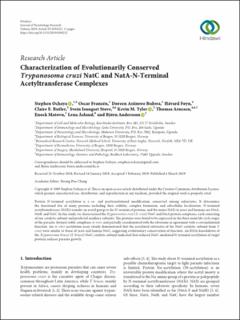| dc.contributor.author | Ochaya, Stephen | |
| dc.contributor.author | Franzén, Oscar | |
| dc.contributor.author | Buhwa, Doreen Asiimwe | |
| dc.contributor.author | Foyn, Håvard | |
| dc.contributor.author | Butler, Claire E. | |
| dc.contributor.author | Støve, Svein Isungset | |
| dc.contributor.author | Tyler, Kevin M. | |
| dc.contributor.author | Arnesen, Thomas | |
| dc.contributor.author | Matovu, Enock | |
| dc.contributor.author | Åslund, Lena | |
| dc.contributor.author | Andersson, Bjørn | |
| dc.date.accessioned | 2020-06-08T14:46:53Z | |
| dc.date.available | 2020-06-08T14:46:53Z | |
| dc.date.issued | 2019-03-06 | |
| dc.Published | Ochaya, Franzén O, Buhwa, Foyn H, Butler, Støve SI, Tyler KM, Arnesen TA, Matovu, Åslund, Andersson. Characterization of Evolutionarily Conserved Trypanosoma cruzi NatC and NatA-N-Terminal Acetyltransferase Complexes. Journal of Parasitology Research. 2019;2019 | eng |
| dc.identifier.issn | 2090-0031 | en_US |
| dc.identifier.issn | 2090-0023 | en_US |
| dc.identifier.uri | http://hdl.handle.net/1956/22501 | |
| dc.description.abstract | Protein N-terminal acetylation is a co- and posttranslational modification, conserved among eukaryotes. It determines the functional fate of many proteins including their stability, complex formation, and subcellular localization. N-terminal acetyltransferases (NATs) transfer an acetyl group to the N-termini of proteins, and the major NATs in yeast and humans are NatA, NatB, and NatC. In this study, we characterized the Trypanosoma cruzi (T. cruzi) NatC and NatA protein complexes, each consisting of one catalytic subunit and predicted auxiliary subunits. The proteins were found to be expressed in the three main life cycle stages of the parasite, formed stable complexes in vivo, and partially cosedimented with the ribosome in agreement with a cotranslational function. An in vitro acetylation assay clearly demonstrated that the acetylated substrates of the NatC catalytic subunit from T. cruzi were similar to those of yeast and human NatC, suggesting evolutionary conservation of function. An RNAi knockdown of the Trypanosoma brucei (T. brucei) NatC catalytic subunit indicated that reduced NatC-mediated N-terminal acetylation of target proteins reduces parasite growth. | en_US |
| dc.language.iso | eng | eng |
| dc.publisher | Hindawi | en_US |
| dc.rights | Attribution CC BY | eng |
| dc.rights.uri | http://creativecommons.org/licenses/by/4.0/ | eng |
| dc.title | Characterization of Evolutionarily Conserved Trypanosoma cruzi NatC and NatA-N-Terminal Acetyltransferase Complexes | en_US |
| dc.type | Peer reviewed | |
| dc.type | Journal article | |
| dc.date.updated | 2019-11-13T13:52:59Z | |
| dc.description.version | publishedVersion | en_US |
| dc.rights.holder | Copyright 2019 Stephen Ochaya et al. | en_US |
| dc.identifier.doi | https://doi.org/10.1155/2019/6594212 | |
| dc.identifier.cristin | 1714340 | |
| dc.source.journal | Journal of Parasitology Research | |
| dc.relation.project | Helse Vest RHF: 912176 | |
| dc.relation.project | Norges forskningsråd: 249843 | |

